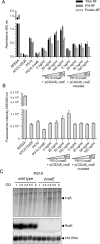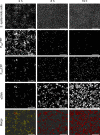The small non-coding RNA RsaE influences extracellular matrix composition in Staphylococcus epidermidis biofilm communities
- PMID: 30870530
- PMCID: PMC6435200
- DOI: 10.1371/journal.ppat.1007618
The small non-coding RNA RsaE influences extracellular matrix composition in Staphylococcus epidermidis biofilm communities
Abstract
RsaE is a conserved small regulatory RNA (sRNA) which was previously reported to represent a riboregulator of central carbon flow and other metabolic pathways in Staphylococcus aureus and Bacillus subtilis. Here we show that RsaE contributes to extracellular (e)DNA release and biofilm-matrix switching towards polysaccharide intercellular adhesin (PIA) production in a hypervariable Staphylococcus epidermidis isolate. Transcriptome analysis through differential RNA sequencing (dRNA-seq) in combination with confocal laser scanning microscopy (CLSM) and reporter gene fusions demonstrate that S. epidermidis protein- and PIA-biofilm matrix producers differ with respect to RsaE and metabolic gene expression. RsaE is spatiotemporally expressed within S. epidermidis PIA-mediated biofilms, and its overexpression triggers a PIA biofilm phenotype as well as eDNA release in an S. epidermidis protein biofilm matrix-producing strain background. dRNA-seq and Northern blot analyses revealed RsaE to exist as a major full-length 100-nt transcript and a minor processed species lacking approximately 20 nucleotides at the 5'-end. RsaE processing results in expansion of the mRNA target spectrum. Thus, full-length RsaE interacts with S. epidermidis antiholin-encoding lrgA mRNA, facilitating bacterial lysis and eDNA release. Processed RsaE, however, interacts with the 5'-UTR of icaR and sucCD mRNAs, encoding the icaADBC biofilm operon repressor IcaR and succinyl-CoA synthetase of the tricarboxylic acid (TCA) cycle, respectively. RsaE augments PIA-mediated biofilm matrix production, most likely through activation of icaADBC operon expression via repression of icaR as well as by TCA cycle inhibition and re-programming of staphylococcal central carbon metabolism towards PIA precursor synthesis. Additionally, RsaE supports biofilm formation by mediating the release of eDNA as stabilizing biofilm matrix component. As RsaE itself is heterogeneously expressed within biofilms, we consider this sRNA to function as a factor favoring phenotypic heterogeneity and supporting division of labor in S. epidermidis biofilm communities.
Conflict of interest statement
The authors have declared that no competing interests exist.
Figures








Similar articles
-
A non-coding RNA from the intercellular adhesion (ica) locus of Staphylococcus epidermidis controls polysaccharide intercellular adhesion (PIA)-mediated biofilm formation.Mol Microbiol. 2019 Jun;111(6):1571-1591. doi: 10.1111/mmi.14238. Epub 2019 Apr 6. Mol Microbiol. 2019. PMID: 30873665
-
AraC-Type Regulator Rbf Controls the Staphylococcus epidermidis Biofilm Phenotype by Negatively Regulating the icaADBC Repressor SarR.J Bacteriol. 2016 Oct 7;198(21):2914-2924. doi: 10.1128/JB.00374-16. Print 2016 Nov 1. J Bacteriol. 2016. PMID: 27501984 Free PMC article.
-
Transcriptional Regulation of icaADBC by both IcaR and TcaR in Staphylococcus epidermidis.J Bacteriol. 2019 Feb 25;201(6):e00524-18. doi: 10.1128/JB.00524-18. Print 2019 Mar 15. J Bacteriol. 2019. PMID: 30602488 Free PMC article.
-
Polysaccharide intercellular adhesin in biofilm: structural and regulatory aspects.Front Cell Infect Microbiol. 2015 Feb 10;5:7. doi: 10.3389/fcimb.2015.00007. eCollection 2015. Front Cell Infect Microbiol. 2015. PMID: 25713785 Free PMC article. Review.
-
The Many Facets of the Small Non-coding RNA RsaE (RoxS) in Metabolic Niche Adaptation of Gram-Positive Bacteria.J Mol Biol. 2019 Nov 22;431(23):4684-4698. doi: 10.1016/j.jmb.2019.03.016. Epub 2019 Mar 23. J Mol Biol. 2019. PMID: 30914292 Review.
Cited by
-
Thirty Years of sRNA-Mediated Regulation in Staphylococcus aureus: From Initial Discoveries to In Vivo Biological Implications.Int J Mol Sci. 2022 Jul 1;23(13):7346. doi: 10.3390/ijms23137346. Int J Mol Sci. 2022. PMID: 35806357 Free PMC article. Review.
-
Discovery of Two Brominated Oxindole Alkaloids as Staphylococcal DNA Gyrase and Pyruvate Kinase Inhibitors via Inverse Virtual Screening.Microorganisms. 2020 Feb 20;8(2):293. doi: 10.3390/microorganisms8020293. Microorganisms. 2020. PMID: 32093370 Free PMC article.
-
Staphylococcal Biofilm Development: Structure, Regulation, and Treatment Strategies.Microbiol Mol Biol Rev. 2020 Aug 12;84(3):e00026-19. doi: 10.1128/MMBR.00026-19. Print 2020 Aug 19. Microbiol Mol Biol Rev. 2020. PMID: 32792334 Free PMC article. Review.
-
RNase III CLASH in MRSA uncovers sRNA regulatory networks coupling metabolism to toxin expression.Nat Commun. 2022 Jun 22;13(1):3560. doi: 10.1038/s41467-022-31173-y. Nat Commun. 2022. PMID: 35732654 Free PMC article.
-
Regulation of biofilm formation by non-coding RNA in prokaryotes.Curr Res Pharmacol Drug Discov. 2022 Dec 29;4:100151. doi: 10.1016/j.crphar.2022.100151. eCollection 2023. Curr Res Pharmacol Drug Discov. 2022. PMID: 36636617 Free PMC article. Review.
References
Publication types
MeSH terms
Substances
LinkOut - more resources
Full Text Sources
Molecular Biology Databases
Research Materials

